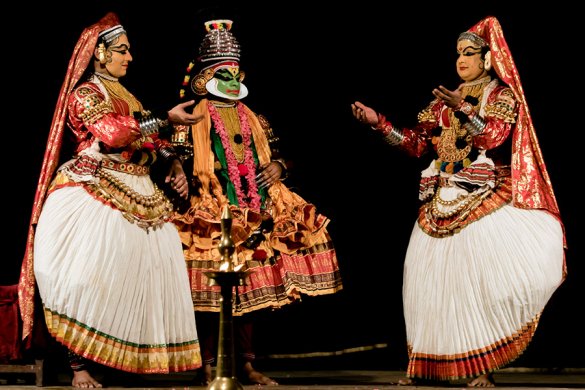
|   |

|   |
Krishnaleela: A tale of two mothers - Hareesh N Nampoothiri e-mail: newn.haree@gmail.com June 12, 2015 A mother finding it hard to realize that the one who freed her from chains is her own son and greets him as her savior. ‘Krishnaleela’ (by Dr. P. Venugopalan), one of the most successful Kathakali plays written in the last two decades, opens with this scene between Devaki and her son Krishna, meeting for the first time after the latter kills Kamsa and releases his parents from jail.  Kalamandalam Adithyan, a promising young actor, appeared as Krishna and impressed with his mature acting, swift footwork and vivid gestures. One thing he could have done better was to fine-tune his body postures in a way adding gist to those strong feelings that he was trying to emote. Kalamandalam Vijayakumar, an actor who has shown his mettle over the years, played the role of Devaki to perfection in the first scene. “Sreepathe! Dayanithe...,” the padam speaks in plenty of the character’s emotions, troubles she had in the past and how she feels about seeing her son after all these years. Vijayakumar resorted to a minimalistic approach and only hinted about it when he portrayed Devaki speaking of the loss of all her other children. On the other hand, while speaking of the hardships of staying locked behind the stone walls, the actor aptly chose to elaborate. The vocalists Kalamandalam Babu Namboothiri (who originally composed the padams when the play was first staged) and Kalamandalam Krishnakumar contributed well to the scene with their inspired rendering, as they efficaciously moved through the stanzas set to Neelambari, Sahana, Dwijavanti and Revati. Seeing Devaki still down and hearing that it is because she missed all his childhood days, Krishna tries to comfort her. He assures her that his foster-mother Yashoda, who has accompanied him to Dwaraka, can narrate them in detail. The idakkalasam repeating the passage “Arutharuthathiniha...” was presented well by Adithyan and together with Vijayakumar's responses, effectively translated the mood of the mother and her son having a good time together. Later, Krishna leaves his mother assuring to be back soon and Yashoda enters. “Nandakumaraleelakal...,” the story telling padam of Yashoda, elevates the play into newer heights as the actor in the role gets plenty of opportunities to narrate the stories making best use of the technique of Pakarnattam. The padam touches upon the various balyaleelas of Krishna like Poothanamoksham, Uloohalabandhanam, Bakasuravadham, Kaliyamardanam and Govardhanodharanam. Kalamandalam Shanmukhadas, who has done the role a number of times in the past, was at ease in portraying Yashoda. Alas, he hardly got any support from Vijayakumar in this scene. His Devaki stayed indifferent, showing no interest whatsoever in the stories narrated by Yashoda. One could only wonder why the actor who performed exceptionally well in the first part suddenly became impassive here in the second half. Adding to it, the singers also failed to give their best in the rendering of the padam and the scene being the crux of the play, ended up insipid! The play concludes with an emotive scene in which Yashoda takes her leave without her foster-child. Singers came back well here and made the two line padam set to Subhapanthuvarali an all absorbing one. Shanmukhadas, Vijayakumar and Adithyan acted well enough to make the scene worthy of a finale. Margi Ratnakaran, an accomplished maddalam artist, made his presence felt throughout, as he accompanied the lady characters on stage. Kalamandalam Sreekanth Varma and Kalanilayam Krishnakumar played chenda and idakka alternatively. At times they fell short of what was expected from them. Margi Ravindran Nair did the chutty. The event was organized by Drisyavedi on 6th of June as their monthly Kathakali program and was staged at Karthika Thirunal Theater, Thiruvananthapuram. PS: Behind the stage information is that no fans were arranged and it was too tiring for the artists to be on the stage lighted up using halogen lamps. This also needs to be taken into account while reading through the shortfalls of the performance. Hareesh N. Nampoothiri is a visual design consultant by profession, an art lover by obsession and a photographer who specializes in dance photography. He writes regularly on classical dance performances and films for various web / print media. He is also an author of three books; director of ‘Thouryathrikam,’ a documentary feature on Kathakali and the founder of NEWNMEDIA™, a firm providing digital design solutions. |